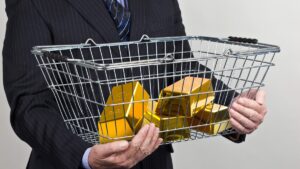SUNDAY ROAST: The small caps that lit a fire under Stockhead’s experts this week

Picture: Getty Images
Goooold.
There’s a lot of talk about gold right now. There always is in times of economic uncertainty.
But really, when it comes to Australian investors, talk of gold is never far away. Here’s a fun fact – Australia was the first country to launch a gold bullion ETF.
Earlier this week, the world’s first gold bullion ETF – Gold Bullion Securities – turned 20. It was launched by Graham Tuckwell in 2003 and is now known as Global X Physical Gold ETF (ASX:GOLD).
It’s one of the largest and most heavily traded ETFs in Australia; in fact, on March 22, as the yellow metal touched an all-time AUD high, it was the most traded ETF in Australia.
Tuckwell said when it first launched the ETF was selling for ~$5.70 and is now worth around $27. Adjusted for inflation, it has risen about four-fold over the 20 years in line with the gold price.
Tuckwell’s son David is now an investment analyst with Global X. He says gold’s popularity is due to its status as a kind of “insurance policy” when times are bad.
“Gold is very similar in that investors will put a small amount of their portfolio into gold, around 5%, and hope for the large part that it doesn’t perform well,” he said.
Although, its six-month rise of 20% has certainly kept plenty of portfolios warm.
So what ETFs offer a simple, cost-effective exposure to the precious metal? There are four physical gold ETFs listed on the ASX:
Global X Physical Gold (ASX:GOLD)
Perth Mint Gold (ASX:PMGOLD)
BetaShares Gold Bullion ETF – Currency Hedged (ASX:QAU), and
VanEck Gold Bullion ETF (ASX:NUGG)
They vary greatly in size, from GOLD with $2.6bn in Funds Under Management, to the newest, NUGG, with around $4m. QAU’s had a solid run of $114m in net inflows recently, due mainly to investors who “may want to hedge their exposure to the US dollar”.
A major difference is whether your ETF uses allocated or unallocated gold. PMGOLD is an example of unallocated gold as the Perth Mint holds the gold on your behalf. That allows it to charge a lower management fee, but things could get curly for you if there was a run on the custodian bank.
There are also two ETFs covering actual gold miners:
VanEck Vectors Gold Miners ETF (GDX). Unhedged, exposure to around 50 miners, focus on North America, 0.53% per year management fee, $490 million in assets under management.
BetaShares Global Gold Miners ETF – Currency Hedged (MNRS). Hedged, around 50 miners, charging 0.57% per year (because of the hedging protection, ~$61 million in AUM.
GDX has more Australian gold mining companies and tighter spreads than MNRS (0.21% vs 0.43% respectively).
Romano Sala Tenna
Portfolio manager, Katana Asset Management
And gold is exactly where Sala Tenna is finding shelter from the storm right now, along with a bit of lithium.
The Perth-based boutique investment funds firm usually holds between 55 to 65 stocks, but right now they are sitting at 42.
“We don’t like being here but it is a reflection of the fact that there’s a lot we don’t want to be invested in right now,” he says.
That includes energy stocks (GDP drives oil prices), financials, and high P/E companies (rising yields). Although that last one might be set to change soon as rates get close to peaking and possibly rolling over.
Right now though, Sala Tanna’s top picks are:
REGIS RESOURCES (ASX:RRL): “It’s hard to go past the gold sector right at the moment.”
Regis is the largest dedicated Aussie gold producer and all their assets are in WA. “There’s probably no better jurisdiction for gold mines in the world than WA in terms of support, expertise and infrastructure.
“They’ve got two very good assets, long-life assets which will be heading into a bit of a sweet spot in terms of having lower-strip ratios and higher-grade material, so we should see some really nice recoveries and some improvements in their cost of production and cash flow,” he explains.
RRL has also been encumbered by a “problematic” hedge book, but it’s now close to winding down.
RESOLUTE MINING (ASX:RSG): It’s “speculative”, Sala Tanna admits, but if you’re a true gold believer, RSG is a high-risk and potentially high return play, “producing 350,000 ounces and their market capitalisation is only $800 million”.
“The big news for them is Syama North, which is about six or seven kilometres away from their existing plants. Once they confirm that development, it’s going to improve their production and dramatically decrease their cost of production as their cost base is largely fixed.”
And the big play, MINERAL RESOURCES (ASX:MIN): This makes up 8% of Katana Asset Management’s portfolio.
The company has four divisions, which are all looking to double their revenue and profits over the next two-and-a-bit years, Sala Tenna says.
“They’ve got a mining services division, [and] lithium, which will be one of the top 2-3 lithium producers of spodumene globally, and the third is their iron ore division, which is looking to double over the next two years with the bringing on of Ashburton,” he says.
“And then finally, they have (an emerging) gas division.
“The stock is running from 0.90 in 2006 to $78 today – it’s a phenomenal company with great long-term growth.”
The views, information, or opinions expressed in the interviews in this article are solely those of the interviewees and do not represent the views of Stockhead. Stockhead does not provide, endorse or otherwise assume responsibility for any financial product advice contained in this article.
UNLOCK INSIGHTS
Discover the untold stories of emerging ASX stocks.
Daily news and expert analysis, it's free to subscribe.
By proceeding, you confirm you understand that we handle personal information in accordance with our Privacy Policy.








